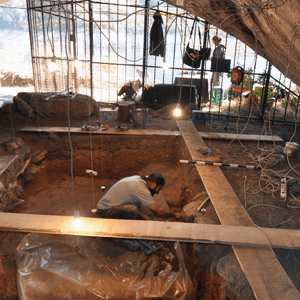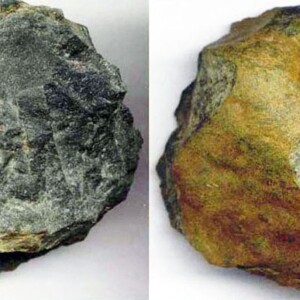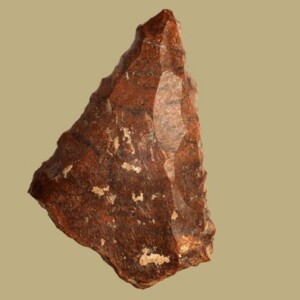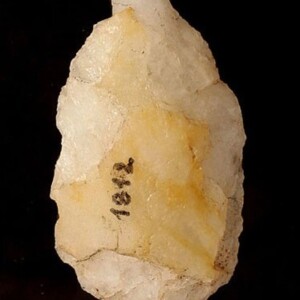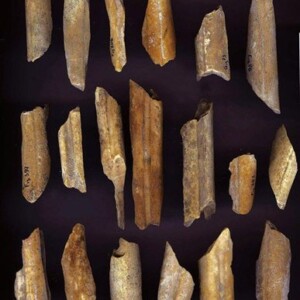
The Paleolithic collection in the NI Archaeological Museum of Macedonia contains materials from the sites of Makarovec and Golema Pesht, and various raw materials from many micro-regions in Macedonia.
During paleontological surveys in the mid XX century, in the central part of Macedonia, in the cave Makarovec, Veles, (Picture 1) were discovered five stone artifacts, which most likely belong to the Upper Paleolithic period, but which also have a strong connection with the Upper Pleistocene fauna consisting of fossil remains of cave bear, hyena, lion, ibex, wolf, fox, donkey and horse. These materials are located in the upper part of the first showcase. (Picture 2)
At the end of XX and beginning of XXI century, a prospection was made of 45 caves and rock shelters along the course of the rivers Babuna in the Veles region and Treska in the Poreče region, as well as in the southwestern, eastern and northeastern micro-regions of Macedonia. In the first showcase there are several types of material with a specific structure, hard stone with conhoidal fracture and stone as potential raw material for making chipped stone tools.
Most of the archaeological materials from this Paleolithic collection originate from the site of Golema Pešt, village of Zdunje in the Gorno Poreče region and 65 km from the capital city of the Republic of Macedonia, Skopje. It is a simple and dry cave, 31m long and 18.5m wide. The entrance is at the southeast, at an elevation of 460m above sea level. (Picture 3) Excavations were conducted sporadically from 1999 till today, and thousands of stone artifacts and fossilized animal remains were recovered. (Picture 4) Representative material for the new permanent exhibition contains 473 individual lithic artifacts and examples of fauna.
In first showcase are placed typical cores and tools that characterize the Upper Paleolithic. There are cores with one or two platforms and cores with a change of orientation. Among the tools in the showcase, the following can be found: side scrapers, perforators, retouched flakes, denticulated and notched tools, splintered pieces and others. The relative chronological dating, according to typological and technological characteristics and analysis of the ash, refers to 40,000 years BC.
In the second showcase, levallois (Picture 5V) and discoid cores and flakes are presented. Denticulated and notched tools are represented but retouched flakes are the most numerous. With fewer examples, perforators, points (Picture 5A and B) and sidescrapers are represented. The material undoubtedly indicates Mousterian origin with emphasized microlitization. From radiocarbon analysis, dates between 47.100 ± 4.800 and >50,000 years BC were obtained, which correspond to the Late Middle Paleolithic or the end of Mousterian. The carrier of the Mousterian culture was the Neanderthal.
Most of the examples from the Upper and Middle Paleolithic are made of quartz; in smaller percentages quartzite, jasper, flint, rhyolite and basalt are included.
The fourth showcase contains a great deal of lithic material from heterogeneous groups of chain operations, or the workshop. They include chips, fragments, retouched flakes, unretouched flakes covered with cortex, burned artifacts, artifacts broken from use and discarded, debitage, cores from breaking, cores with traces from tests, and other forms characteristic for the technological process “from raw material to finished tool.” The fossilized animal bones are a constituent part of this workshop, and they were accumulated and modified by man. The largest number of remains belongs to deer, but also other large fauna are identified: roe deer, alpine ibex, wild boar, cave hyena, cave bear, beaver, a small carnivore in the form of a marten, turtle and birds. Among the micro-fauna, most of the remains are from rodents. In the third showcase, specially selected are examples of macro-fauna showing obvious influence of man, such as bone retouchers, fragments with intentional traces, e.g., engraving of stone artifacts, burned fragments, a deliberately longitudinal cut of the long bones of deer, smashed phalanges from a deer.
Interdisciplinary research, which involves radiocarbon analysis, determination of micro- and macro-faunal remains, analysis of volcanic ash, geological surveys and typological and technological characteristics, provided the following results, which confirm that the cave was intensely populated for a long period of time and has parallels with other Middle Paleolithic and Upper Paleolithic industries of the central Balkans.
M.A. Ljiljana Šalamanov-Korobar, archaeologist, custodian advisоr for Paleolithic.

